Culture in North India
Ancient temples, forts and palaces
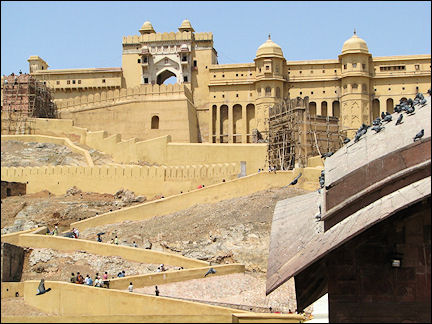
|
North India has many palaces and forts that belonged to great moguls and maharajas. A tour of Delhi (Jama Moshid Mosque, Sikh temple Gurdwara Bangla Sahib, Rashtrapati Bhawan palace, Mahatma Gandhi's home, Red Fort), Jaipur (Pink City, Amber Fort, Monkey Temple), Fatahpur Sikri (Akbar Palace), Agra (Taj Mahal, Red Fort), Khajuraho (Chandela temples) and Varanasi (Fort Ramnage, gaths along the Ganges) and to the Nepal border.
Travelogue & photos: Hetty Dirksen
Delhi
The Red Fort has marble pavillions and bathhouses
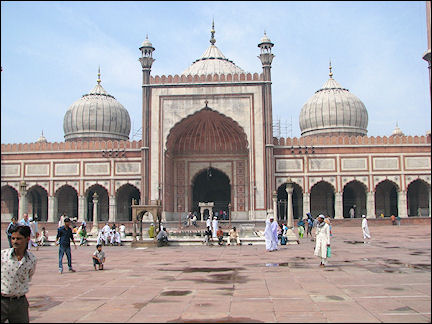
|
After we get through immigration, we find ourselves in a big crowd. Left and right are lines of people with signs. At the end we see Ans' sign: she will be our guide. On the shuttle to Hotel Good Times on Pusa Road I get my first glimpses of this big city.
Later we will find out that this is quiet, even though this early in the morning there are already lots of people in the streets: some are still sleeping, on the side of the road, sometimes under a piece of cloth. People are washing themselves. Children in blue uniforms are on their way to school, walking or in rickshaws, some are taken to school in a car or on a motor bike.
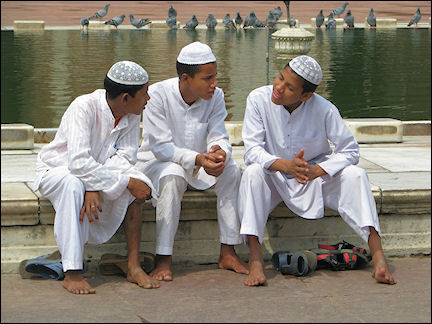
|
Traffic is chaotic and a constant honking is going on. I see that the wing mirrors on many cars are folded in. Okay, I understand that if they're out, you risk having them taken off by another car, but this way they're no use anyway. And then there are bikes, camels and cows amidst the stream of cars.
After breakfast on the roof terrace of the hotel we go into town in motor rickshaws. We get into the flow of Indian traffic: men with large grey beards, wearing turbans, ride scooters, and then there are of course the holy cows. An overwhelming stench of dung, car exhaust, smog, burning trash and so on, fills our lungs.
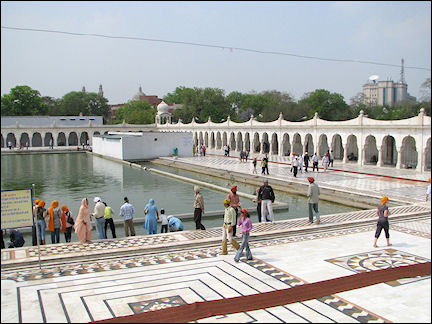
|
We visit the Jama Mashid Mosque. The largest mosque of India is built with red sandstone. The domes are made of white marble, which is a beautiful contrast.
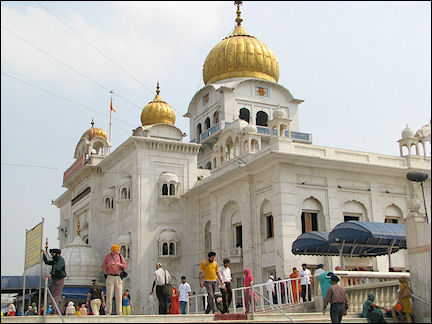
|
We get a guided tour in the Sikh temple Gurdwara Bangla Sahib. Outside the temple is a large, beautiful white marble pond.
Delhi's old city center has red brick buildings, the great moguls' heritage. The great moguls were a Central Asian Muslim dynasty which ruled over the Mogul Empire of which India was a part from 1526-1857. Mogul is a corruption of the word Mongol.
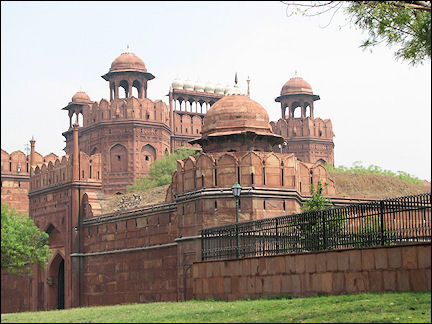
|
The famous Red Fort was built in 1639, commissioned by Shah Jahan, who moved his capital from Agra to Delhi. Within the walls of the fort are marble pavillions and bathhouses. Unfortunately we can't go inside.
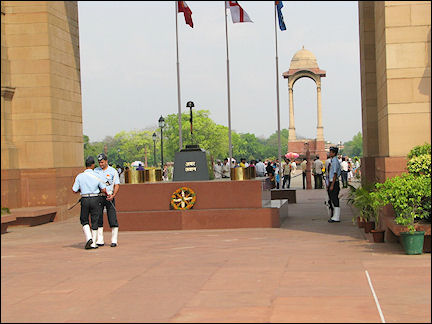
|
We visit New Delhi in a rickshaw. The new city has wide avenues, posh buildings and large embassies. Poor people and bicycle rickshaws are not allowed here. New Delhi is less noisy and crowded than the old city.
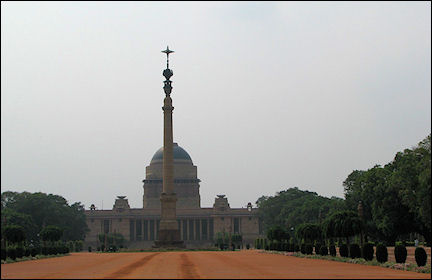
|
India Gate is een triumphal arch which is a monument for the Indian soldiers who died in WWI. A beautiful avenue, Raj Path, leads from here to the Rashtrapati Bhawan Palace. This used to be the residence of the British vice-roys. Nowadays it is the official residence of the Indian president.
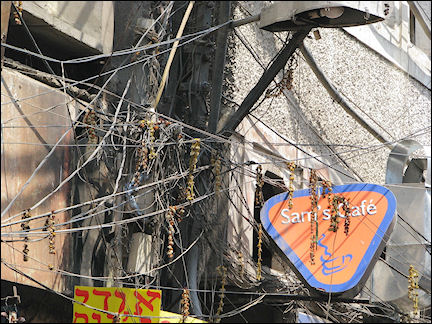
|
We have lunch in Old Delhi in the backpackers district, a maze of streets and alleys, teeming with people, ox-wagons, bicycles, horse-and-wagons and everything else that can move. Looking along the buildings, you see large tangles of electric wires. Power outages are frequent. The streets are narrow and there is a lot of activity going on.
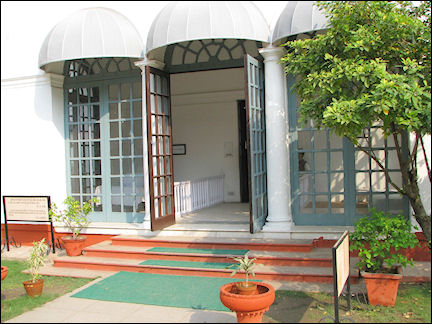
|
In the afternoon I visit Mahatma Gandhi's house. He was murdered on January 30, 1948 by and extremist Hindu who thought Mahatma Gandhi was too supportive of Muslim rights. Gandhi's home now houses a permanent exhibition about his life. There are many Gandhi statues in the garden, and everywhere you see shields with famous quotes of his.
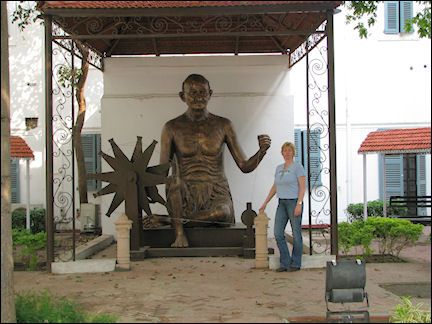
|
In the evening we have dinner in a specialized Thali restaurant. Thali is a dish that is served on a round tray, which is called thali, with at least eight small bowls, katori, with different kinds of food. Apart from this, there are sauces, rice and naan bread. It is delicious.
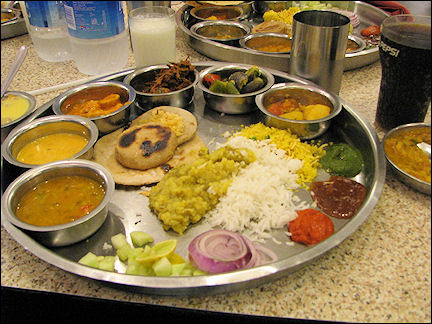
|
The next morning I visit the Lakshmi Narayan Temple, a wonderful Hindu Trinity-tempel which is mainly freqented by women. It is very crowded in there. I have a great time watching the women in their beautiful saris.
Train ride Delhi - Jaipur
Kilometers of the worst poverty along the tracks
We take the 3 PM train to Jaipur. It's a huge train and we have to walk quite a distance to the front to find our car. The cars with barred windows are third class, people sit huddled against one another there.
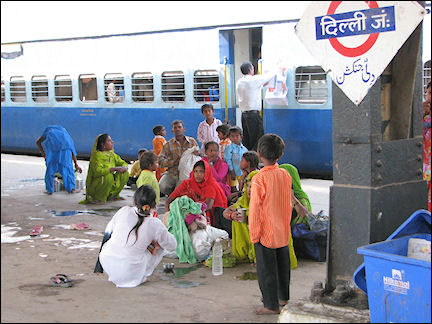
|
Our second class car doesn't have bars over the windows and it has fans that at least bring some cool. On the outside of the car are computer-made banners with the names of the passengers. Fun, I see my name written in Indian letters (Sanskrit).
It's busy on the platform: people are sitting down in groups, eating, other try to sell drinks or food, a man sells chains and locks to secure your luggage with, in case some one wants to steal it while you're sleeping during this long train ride.
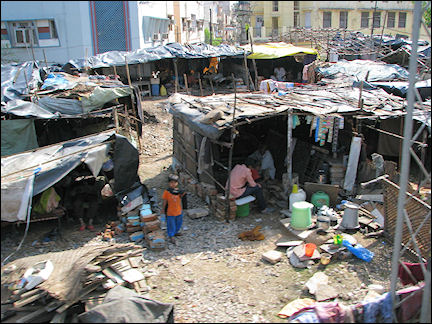
|
When the train has just left the station, we see the poorest of the poor, who live by the sides of the tracks. This is grinding poverty: they own a piece of agricultural plastic sheet, a piece of corrugated iron, or nothing at all. The train door is open and I take pictures, many, I don't know why.
This goes on for kilometers; I have seen poverty on TV, but in reality it's a much harsher confrontation and it also smells bad.
When we leave the city and its poverty, we see vast fields of grain, a house or a tree every now and then, a herd of camels and colorful people. The women wear pretty saris in bright colors.
We arrive in Jaipur at 9 PM; it's already dark. The next three nights we will stay in Hotel Bissau Palase, a beautifully painted, large old palace. It used to belong to a maharaja, but it's been in use as a hotel since 1969.
Jaipur
The famous inner city has faded to orange
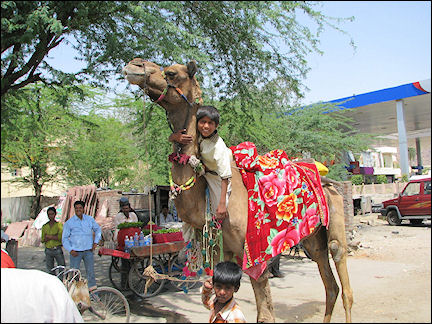
|
Jaipur is the capital of Rajasthan ("Land of the Queens") province. Jaipur is known as Pink City. A maharaja once ordered the complete inner city painted pink. Even though it is delapidated and the pink has faded to orange, it is still impressive.
After breakfast and some shopping we take a rickshaw to the Amber Fort, 10 kilometers outside the city. On the way we see beautifully painted elephants with loads on their backs. It's still weird to see elephants as traffic participants. There are also lots of camels, all of them with pretty decorations.
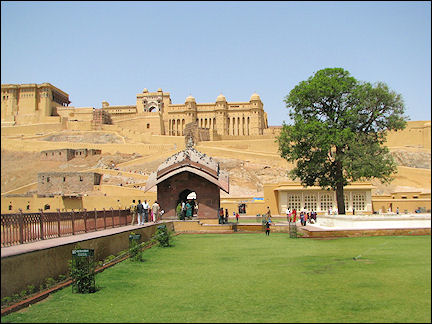
|
The Amber Fort is an enormous complex, remarkably well maintained. It was built in the mid-sixteenth century by Raja Man Singh, a so-called Rajput officer in the army of Great Mogul Akbar. The Jai Sigh maharajas expanded the fort in later times.
It's very hot outside, but in the rooms of this fort it's cool. Beggars are sitting everywhere on the road up, and there are also monks who, even though I don't understand them, will wish you a good life for a few rupis.
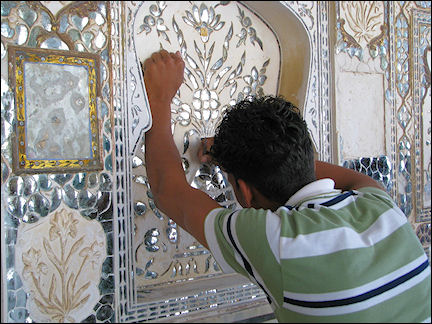
|
The walls are covered with beautifully inlaid panels with shiny mirrors and stones. You have a great view from the fortification walls. An almost 20 kilometers long wall runs from the fort around the city and from here I get a good overview of it.
Camel Safari
School children sing for us
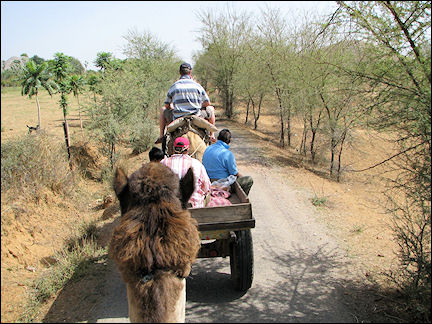
|
The next morning, after a delicious breakfast with lasi, a yoghurt drink that is made with all kinds of fruit, a bus takes us to the hunting lodge of the maharaja. There we leave for a camel safari.
It's very hot and we have to bring lots of water and a hat. There are little flat carts that are pulled by camels, but you can also sit on camels themselves.
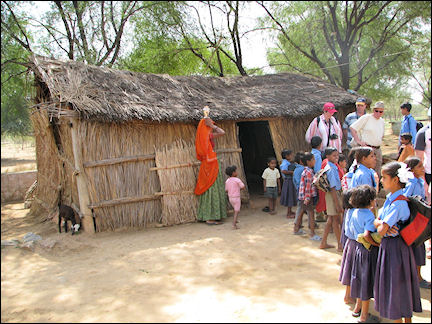
|
On the way we visit two villages and a school. The school children sing Frère Jacques for us. Not sensational, but they are happy with the cookies our guide brings them, and they all want to be in our pictures. We get a guided tour of the village and get an impression of how these people live.
After visiting another village we return to the hunting lodge for a wonderful lunch.
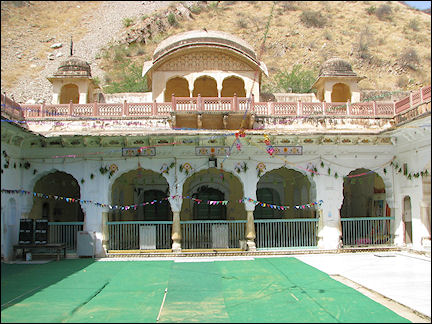
|
In the afternoon we visit the Monkey Temple. Supposedly around 20,000 monkeys live here, but I don't see that many. I also keep my distance, because I don't want to get bitten by a monkey. I pay a rupi to take a picture of a Saddhu, they are so-called holy men who live on alms.
Back in our hotel we spend the rest of the afternoon around the pool.
Jaipur - Agra
Because of the drought few birds are left in Keoladeo
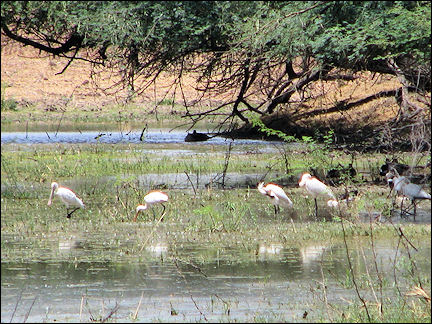
|
We leave early for Agra. On the way we visit Keoladeo, a bird sanctuary near the town of Bharatpur. A few rickshaws take us into the park. There has been a serious drought over the last couple of years, so there are hardly any birds left of the over 300 kinds that used to live here. It's also hard on the rickshaw riders, because hardly any tourists visit here anymore.
Near Agra we visit Fatahpur Sikri (16th century), the former capital of Great Mogul Akbar. This city was built with red bricks as well; according to our guide they once were covered with precious stones, but like many Indian art treasures, they were taken apart by the British and shipped to England.
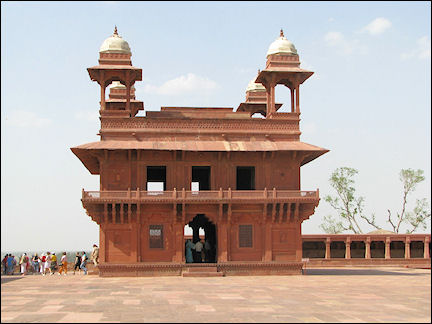
|
The sovereign had three women live on his property: a Hindu, a Muslim and a Christian. For each of them he built a residence. Almost everything imaginable is sold within the walls of this complex, but the vendors are pushy and I am getting fed up with them.
When I take a picture of a twelve-year-old kid, who jumps into a water basin from an impressive height, he immediately comes up to me and asks money for the picture. I give him 5 rupis, but that's not enough, as he loudly insists.
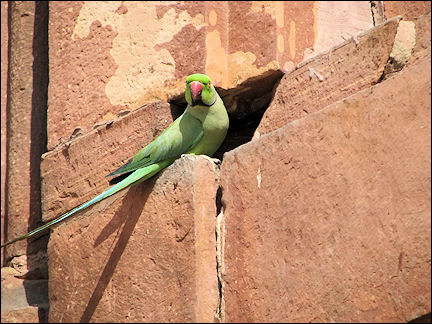
|
No one does anything about these pushy people. Once on the bus, we have to ask the driver to send the venders off. They follow us on to the bus and ignore our protests.
After another hour on the bus we arrive in Agra, where we spend the night in Hotel Amar, an excellent hotel with pool.
Agra
Taj Mahal is at its most beautiful at sunrise
We leave at 5:45 AM for the Taj Mahal. When we arrive in our bicycle rickshaws, there already is a line of people waiting to get their tickets. It is already light, but the sun still has to rise, so we are on time to see Taj Mahal at sunrise, when it is supposed to be at its most beautiful.
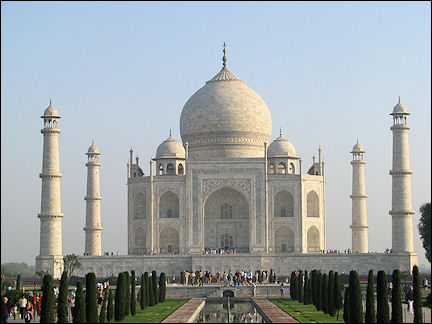
|
After walking a hundred meters or so, I get a full view of the Taj Mahal: its beauty is out of this world. Great Mogul Sjah Jahan commissioned the construction of the Taj Mahal as a memorial for his wife Mumtaz. The construction of the white marble mausoleum took 17 years in the seventeenth century. The building is completely symmetrical.
On the outside this is the most beautiful building I have ever seen. Inside, where the tomb is, it's rather austere, which of course is appropriate.
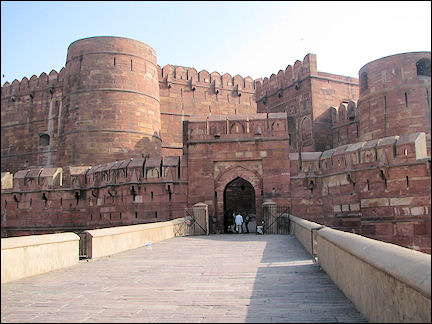
|
When we leave Taj Mahal, our rickshaw is waiting for us and we decide to visit another Red Fort; boy, do they love red in this country...
I feel like wandering on my own, without a guide. But when I sit down a little later on a marble stoop in the shade, one of the guards sits down next to me and before I know we are having a cozy conversation. I answer all his questions about Holland and he tells me about India, his family and of course about the fort. So this way I end up knowing a lot about it after an hour or so of talking.
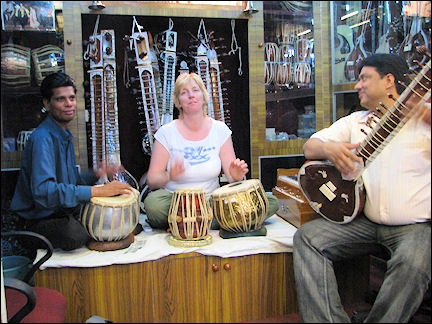
|
On a walk in the city we pass a rather big musical instruments store. Inside an Indian is sitting cross-legged, playing the tabla, two small cone-shaped drums that are played with the fingers and the palm of the hand. He is willing to teach me how. Fun. I sit down beside him and get my own tabla.
After practising a little, I get the rythm, and drum away. The owner sits down with us as well and the three of us play a little concert.
Khajuraho
Unique Chandela temples with gorgeous sculptures
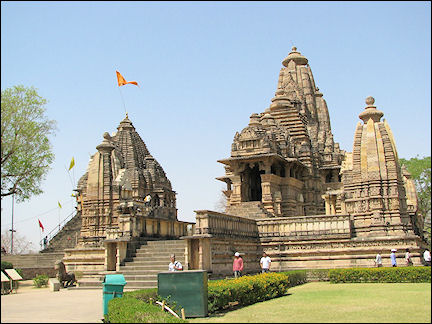
|
The next morning at 5 AM we leave for Khajuraho. It is a beautiful and interesting drive through rural areas. Khajuraho is mostly known for its unique Chandela temples with their gorgeous sculptures, of which the erotic ones are undoubtedly the most famous.
We arrive in Khajuraho at the end of the afternoon. We will spend the night in the Usha Bundela Hotel, which is nice and has a pool. It's more quiet here than in other places we visited so far and I decide to rent a bike when it's offered.
In the evening I go into town by bike, to withdraw money from an ATM. After dinner we bicycle back to our hotel. It's dark now, and our bikes don't have lights, nor are there any street lights. I am a little scared and hope we won't run into potholes, but everything goes smoothly and we arrive unharmed.
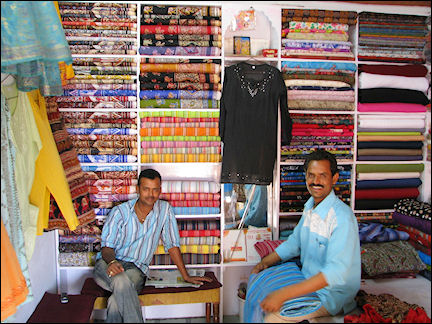
|
The next morning I ride my bike to the eight temples devoted to the well-known Hindu gods. It's already hot when I ride back to my hotel early in the afternoon. I pass a fabric store like many I have seen in India and decide to take a look inside and find out if they can make me a wraparound skirt.
Inside, a man puts a low stool below the fan for me and when I sit, the owner enters. The three of us drink tea and chat for a while. After I have picked the fabric, it takes another half hour to make the skirt. I bicycle back to the hotel, happy with my new skirt for only 500 rupis.
Varanasi
"The Ganges is the life line of Indian culture"
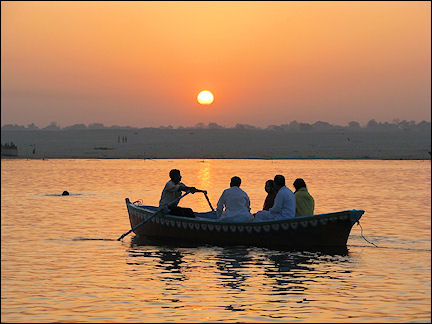
|
Early next morning we travel on to Varanasi, one of the most impressive cities in India and one of the oldest still inhabited cities in the world. We stay in Hotel Pradeep.
Varanasi lies on the banks of the holy river Ganges. Ninety per cent of India's population is Hindu; they believe in reincarnation. To escape from the cycle of birth and rebirth and find eternal peace, Hindus believe you should die in Varanasi and be cremated on the banks of the holy Ganges for your soul to reach Nirvana, the hereafter.
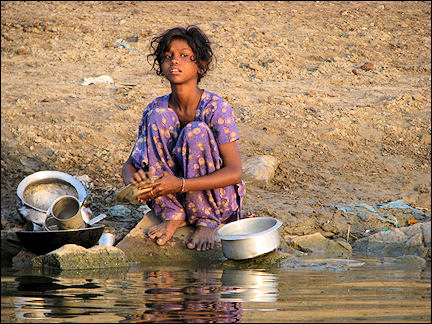
|
Children deserve a second chance at a life on earth and therefore pregnant women and children up to 5 years are not cremated. Wrapped in cloth and weighed down with stones they are sunk in the Ganges after a ceremony.
The soul then will have a chance to be reborn into a life that will hopefully be better than the first one.
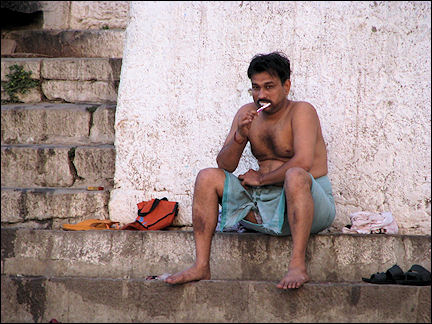
|
Lepers aren't cremated either, but that is because Indians think (incorrectly) that the airborn ashes could infect others. Clergy from the highest caste are considered to have led a life that was holy enough that there is no need to cremate them. So they are also sunk, wrapped in cloth and weighed down with stones in the Ganges.
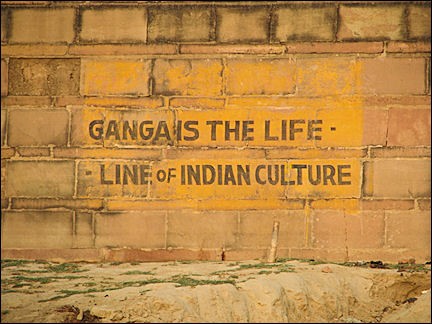
|
The next morning we get up early to see the crowds at the gaths, the steps into the Ganges river, from a boat. Rickshaws take us from the hotel to the gaths. It's crowded in the city, many people are on their way to the morning ritual on the holy river.
I also see people waiting to die. The image of a baby who didn't make it, lying on the side of the road, will stay with me for a long time.
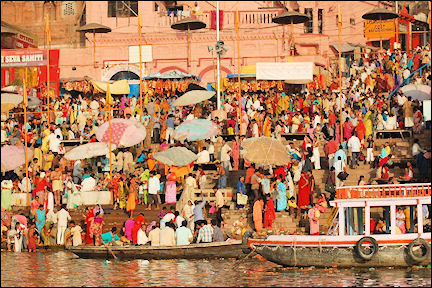
|
A boat is waiting for us when we arrive at the Ganges. Once we're on the water, it strikes me that the river doesn't smell, even though I heard it is one of the most polluted rivers in the world. Hindus consider the Ganges holy and drink the water, wash themselves in it and assume they won't get sick. We see a dead cow float on the river and a little farther a human corpse.
It is busy at the largest cremation site in Varanasi: corpses are cremated continually in public.
When the sun rises at 7:30, we leave and have breakfast at the Dolphin restaurant. The terrace looks out on the Ganges and Varanasi.
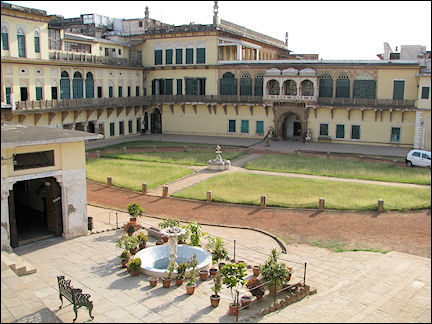
|
In the afternoon I visit the 17th century Fort Ramnager of the maharaja of Benares. It has a large collection of howdahs, seats to ride elephants, and palanquins (covered sedan chairs).
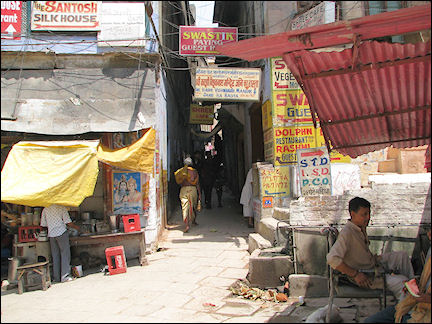
|
The next day we take a walk in the narrow streets of Varanasi. We would call them alleys, but here they are thru-streets. People ride their motorbikes here and if you're out of luck a cow is chewing the cud in the middle of the street, which is then completely blocked.
To Nepal
Royal stay in Shivpatinagar
We leave for Nepal. Tonight we will stay in the village of Shivpatinagar near the border. The Hotel Royal Retreat is surrounded by wild nature.
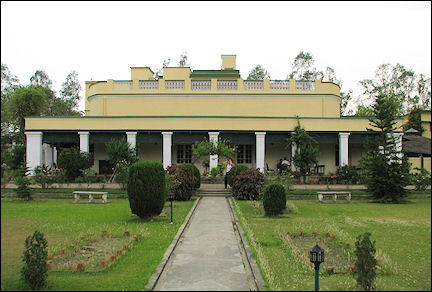
|
The name has historical resonance, because Raj Shivapati Singh, who bought the estate in 1923 from its British builder to use it as a hunting lodge, was the local maharaja. The estate is still owned by the family and nowadays the son-in-law runs the palace turned hotel.
The inside of the hotel breathes the atmosphere of past colonial times. Dusty tiger heads on te walls and rooms decorated in the same colonial style. One thing is certain though: tonight I will sleep like a maharaja!
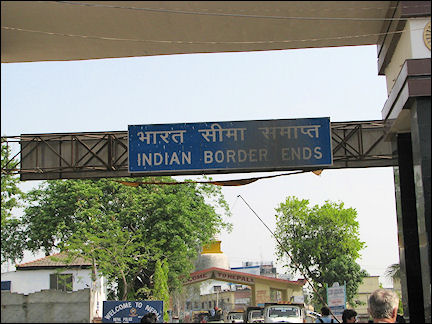
|
Early next morning we drive to the border with Nepal. On the way we see children in school uniforms along the road, waiting for their schoolbus. We stop to take pictures of two cranes in a field and then we're off to Nepal.